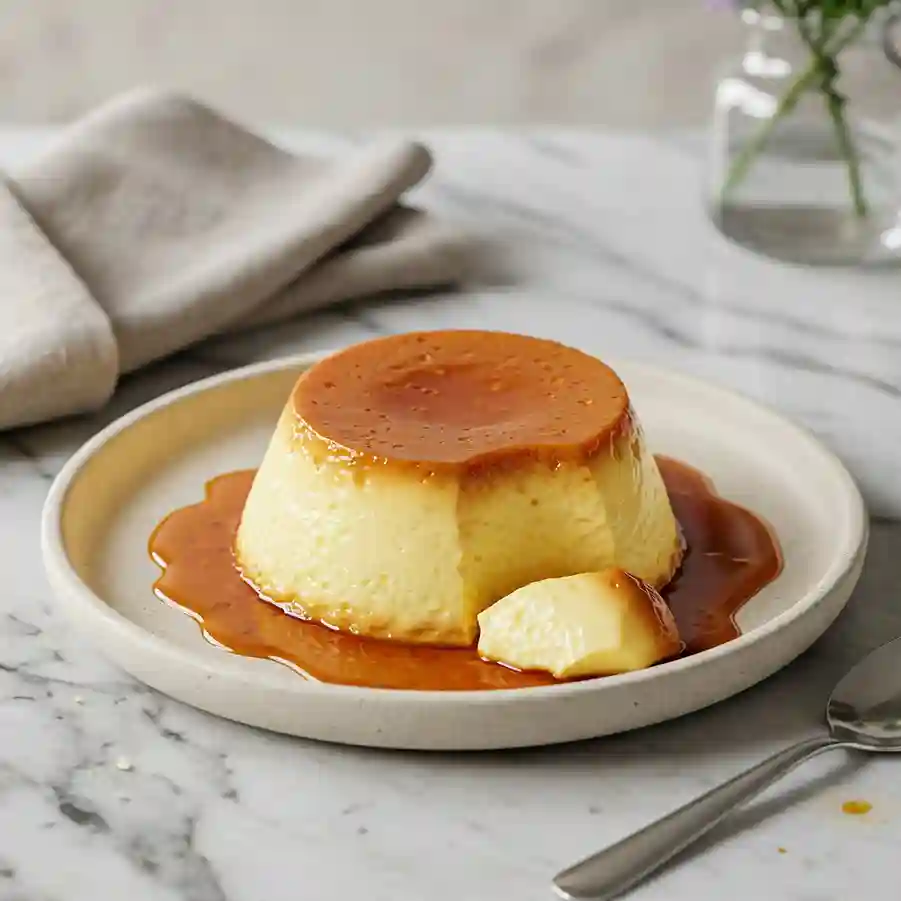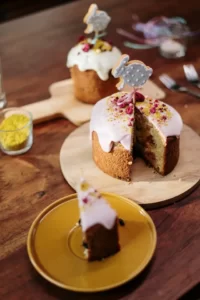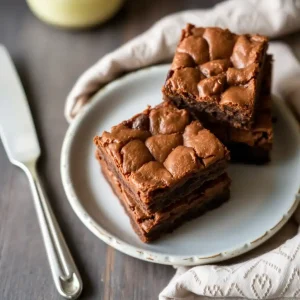Trying to make something that looks elegant but doesn’t take a ton of effort? Want a dessert that’s rich, smooth, and actually worth the time you spend on it?
This French Crème Caramel might look like something you’d only find in a fancy restaurant, but trust me—it’s super simple when broken down the right way.
You’ll get that golden caramel on top and the soft, jiggly custard underneath. It melts on your tongue and leaves behind that deep caramel flavor that lingers in the nicest way.
I’ve tested and written this recipe so that anyone—even someone who’s never touched a whisk—can make it and feel proud.
If you’re planning something special, or you just want to serve a dessert that actually makes people pause for a second before taking their first bite—this is the one to go with.
Table of Contents
ToggleFrench Crème Caramel Recipe
Ingredients
For The Caramel
- ¾ cup (150g) granulated sugar
- 3 tablespoons water
- ½ teaspoon fresh lemon juice
For The Custard
- 2 cups (500ml) whole milk
- ½ cup (100g) granulated sugar
- 4 large eggs
- 2 teaspoons pure vanilla extract
- Pinch of fine sea salt
Instructions
- Preheat your oven to 150°C (300°F). Boil a kettle of water and set it aside—you’ll need it for the water bath.
- In a small, heavy-bottomed saucepan, add the sugar, water, and lemon juice for the caramel. Do not stir. Place over medium heat and allow the sugar to melt and bubble undisturbed until it turns a rich amber color—about 8–10 minutes. Swirl the pan gently if needed to even out the color.
- The moment it hits that deep golden tone, quickly pour the hot caramel into four ramekins (or one 6-inch round cake pan), tilting them gently to coat the bottom evenly. Work fast—caramel sets quickly.
- In a separate medium saucepan, heat the milk over low heat just until warm—not boiling. You should see small bubbles form around the edges. Remove from heat.
- In a mixing bowl, whisk together the eggs, sugar, vanilla extract, and salt. Whisk just until smooth—avoid incorporating too much air.
- Slowly pour the warm milk into the egg mixture, whisking continuously to temper the eggs without scrambling. Once fully combined, strain the custard through a fine mesh sieve into a pouring jug to ensure an ultra-smooth texture.
- Carefully pour the custard over the set caramel in the ramekins. Place them in a deep baking dish.
- Gently pour the hot water into the baking dish until it reaches halfway up the sides of the ramekins—this bain-marie (water bath) will ensure an even, gentle bake without cracks or bubbles.
- Transfer the whole setup to the oven and bake for 35–40 minutes, or until the custards are just set—they should jiggle slightly like gelatin when you tap the side of the ramekin.
- Remove ramekins from the water bath and let them cool at room temperature for 30 minutes, then chill in the refrigerator for at least 4 hours or overnight.
- To unmold, run a thin knife around the edge of the custard. Place a serving plate over the ramekin and swiftly invert—it should release effortlessly with the caramel flowing beautifully over the top and sides.

Success Tips For Making Crème Caramel
Getting a smooth, glossy, and perfectly set crème caramel isn’t hard when you follow a few smart tips.
- Use room temperature eggs: Cold eggs can shock the warm milk and create lumps in the custard. Let them sit out for a bit before using.
- Warm the milk gently: Don’t boil the milk. Just heat it enough to help it mix smoothly with the eggs.
- Strain the custard mixture: This removes bubbles or any cooked egg bits, giving you a super smooth finish.
- Avoid overmixing: Whisk gently to keep air out of the custard. Too much air can cause bubbles and uneven texture.
- Watch the caramel closely: Caramel can burn quickly. Take it off the heat as soon as it turns golden amber.
- Use a water bath: Baking in hot water keeps the custard from cooking too fast and prevents cracks.
- Don’t overbake: The custard should still jiggle in the center. It will firm up as it cools.
Is Crème Caramel The Same As Flan?
This is a common question, and the answer depends on where you are in the world.
Crème Caramel and Flan are very similar, and in many countries, the names are used for the exact same dessert. Both are custards baked with a layer of caramel on top that melts into a sauce when inverted.
But there are small differences in recipes depending on the region:
- In Europe: Crème Caramel is the classic name. It’s usually made with milk, eggs, sugar, and vanilla.
- In Latin America and the U.S.: Flan is the more common term. It sometimes includes sweetened condensed milk or cream for a richer texture.
So, they’re almost the same dessert, just with slight ingredient and naming differences based on culture.
Difference Between Crème Caramel And Crème Brûlée
Even though both desserts are custards, they have big differences in texture and topping.
Here’s a simple comparison to understand them better:
- Topping: Crème Caramel has a liquid caramel sauce on top. Crème Brûlée has a crunchy, burnt sugar crust that you crack with a spoon.
- Baking method: Crème Caramel is baked in a water bath and flipped over before serving. Crème Brûlée is served in the same dish it’s baked in and topped with torched sugar.
- Texture: Crème Caramel is silky and soft. Crème Brûlée is creamier and a bit thicker inside.
- Flavor: Crème Caramel has deep caramel notes. Crème Brûlée has a mix of rich vanilla custard and slightly bitter burnt sugar.
What Does Crème Caramel Taste Like?
Crème Caramel has a soft, creamy taste with a light sweetness that isn’t overpowering. The custard itself is smooth and mild, often flavored with vanilla.
The caramel sauce on top adds a slightly deeper, almost smoky sweetness that balances it perfectly.
When you take a bite, you get:
- Soft vanilla custard: Gently sweet, rich, and silky on the tongue.
- Melted caramel sauce: Slightly bittersweet with a golden sugar flavor.
The mix of the cold, creamy texture and the sweet caramel gives it a satisfying, melt-in-your-mouth experience. It’s not too sweet and doesn’t feel heavy.
Why Did My Crème Caramel Not Set?
If your crème caramel turned out runny or too soft, here are a few possible reasons why:
- Not baked long enough: The custard needs time to cook fully and set. If it’s underbaked, it stays liquid in the center.
- Oven temperature too low: If your oven was cooler than needed, the custard may not have set properly.
- Too much milk or not enough eggs: The balance between eggs and milk is what makes the custard firm.
- Skipping the water bath: Without the gentle heat from the hot water bath, the custard may cook unevenly.
How To Tell When Crème Caramel Is Fully Cooked?
It’s important not to underbake or overbake crème caramel. Here’s how to know when it’s done.
- Look for a gentle jiggle: The center should wobble slightly when you tap the side of the ramekin.
- Edges should be firm: The sides will look set, while the middle is soft but not liquid.
- No bubbling or cracks: If you see bubbles, the oven might be too hot and the custard is overcooking.
- Toothpick test: Insert a toothpick near the center—it should come out clean or with a few creamy crumbs, not wet.
Let it cool fully before refrigerating, as it will firm up more as it chills.
How To Flip And Release Crème Caramel The Right Way?
Getting the custard out cleanly with the caramel sauce on top is easier than you think. Here’s how to do it smoothly:
- Chill it well: Let the crème caramel cool completely in the fridge for at least 4 hours or overnight.
- Loosen the edges: Use a thin knife to gently run around the edge of the ramekin to loosen the custard.
- Warm the bottom: Dip the bottom of the ramekin in warm water for a few seconds to soften the caramel.
- Flip with confidence: Place a dessert plate upside-down on top of the ramekin, hold both together, and flip in one quick motion. Let it sit a few seconds so the caramel can release.
Once released, you’ll see the caramel flowing over the custard beautifully.
How To Serve Crème Caramel?
Crème Caramel is a chilled dessert that’s simple but looks very elegant on the table.
Here are a few easy ways to serve it for the best result:
- Serve it cold: Always chill before serving. It tastes smoother and holds its shape better.
- Use a flat dessert plate: This lets the caramel sauce spread evenly and makes it easy to eat.
- Add fresh fruit (optional): A few berries on the side or a mint leaf on top can make it look extra special.
- Don’t serve with toppings: Avoid whipped cream or sauces—they cover the taste and look of the caramel.
- Serve soon after flipping: Once it’s out of the mold, serve it within 15–20 minutes for the best texture.

How To Store Crème Caramel?
Crème Caramel is great for making ahead and storing. Just follow these tips to keep it fresh and delicious.
- Refrigerate once cooled: Let the custards come to room temperature, then cover and chill them in the fridge.
- Store for up to 3 days: They’ll stay smooth and tasty for about three days in the fridge.
- Keep them covered: Use plastic wrap or airtight containers to prevent them from absorbing other smells.
- Don’t freeze: Freezing changes the texture of the custard and makes it watery after thawing.
- Unmold right before serving: The caramel sauce forms as it chills. Flip it out just before serving for the prettiest look and best texture.
What Could Go Wrong With Crème Caramel?
Crème Caramel is simple, but small mistakes can affect the outcome. Here’s what to watch out for:
- Custard too firm or rubbery: This usually happens if you overbake it or use high heat.
- Caramel turns bitter: If the caramel cooks too long or burns, it can taste sharp instead of sweet.
- Bubbles in custard: Whisking too hard or baking without a water bath can trap air and ruin the smooth texture.
- Custard doesn’t set: Underbaking or not using enough egg can lead to a loose, soupy texture.
- Caramel sticks to the pan: If the caramel sets too hard, it won’t release. Make sure to flip the dessert after chilling, and dip the bottom of the ramekin in warm water for a few seconds to loosen it.
You May Also Like To Check Out These Recipes
- Banana Bars With Cream Cheese Frosting
- Oven Baked Sweet Potato Chips
- Best Indian Mango Chicken Curry
- Viral Tiktok Cucumber Salad
- Lemon Buttercream Frosting
- Peach Ice Cream
- Chocolate Cream Cheese Frosting
- Strawberry Cream Cheese Frosting
- Funeral Potatoes With Hashbrowns
- Chinese Special Fried Rice Restaurant Style
- Authentic Spanish Seafood Paella
- Banana Oatmeal Protein Muffins
- Velvety Cream Cheese Frosting
- Applesauce Muffins
- Baby In Bloom Cake
- Baby Shower Cookies
- Baby In Bloom Cupcakes (Tutorial)
- Homemade Pretzel Crust Pizza
- Cinnamon Rice Pudding With Fresh Cherries
- Tomato Pasta
- Vegan Banana Muffins
- Chocolate Banana Bread
- Moist Banana Chocolate Chip Muffins
- Cheese Danish
- Egg In A Hole
- Breakfast Egg Muffins
- Cheesy Baked Eggs
- Cheesecake Stuffed Strawberries
- German Chocolate Cake
- Chocolate Banana Bread
- Baked Chicken Nuggets
- Moist Banana Chocolate Chip Muffins
- Spring Rolls
- Chicken Egg Rolls
- Virgin Strawberry Daiquiri
- Creamy Cherry Tomato Pasta
- Chocolate Drip Cake With Fresh Fruit
- 5 Ingredient Orange Chicken
- Egg Roll In A Bowl
- Chicken Biryani
- Creamy Mushroom Pasta
- Cucumber Sandwiches
- Chicken Korma
- Cat Birthday Cake
- Gluten-Free Almond Flour Pancakes
- Grilled Fish Tacos With Cabbage Slaw
- Malted Chocolate Milkshake











